

© Shipping Wonders of the World 2012-

The Drama of Life-Saving
To race with death and cheat the storm of the lives of men in stricken ships is a task nobly and bravely accomplished by the lifeboatmen
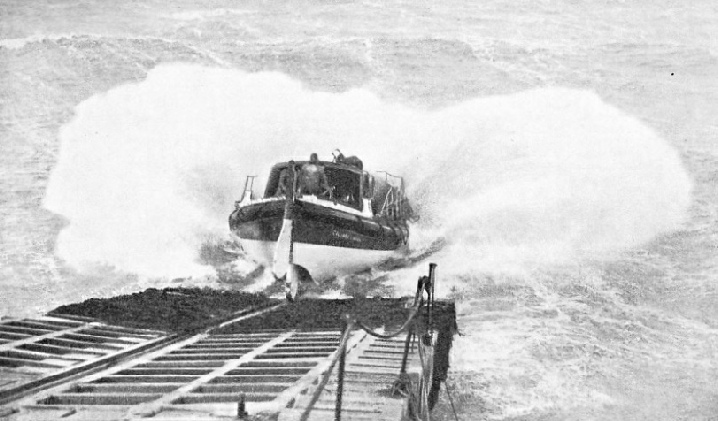
IN THE TEETH OF A GALE. A spectacular picture of the Cromer motor lifeboat being launched to go to the assistance of a steamer in distress during a sixty-
THERE are few more dramatic events associated with the sea than the launching of a shore lifeboat. Let us suppose that a small sailing ship, equipped with an auxiliary motor, is in distress during a gale. Her sails have been blown to shreds and her motor has failed. She is drifting on to dangerous sandbanks guarded by a lightship. Blazing paraffin-
This vessel immediately communicates by wireless telephone with the shore. There coastguards have seen the rocket signals and have fired a rocket in reply. They have also at once warned the lifeboat station, and the lifeboat crew of seven has been summoned by a maroon. Clad in oilskins, sou’-
Despite the heavy seas, the lifeboat is in little danger of being overwhelmed. Air compartments give her great buoyancy, and special scuppers automatically drain the water taken in when she heels over. She is so constructed that the risk of capsizing is slight.
Heavy seas break over the lifeboat when she reaches the sandbank on to which the sailing ship has drifted. But the engine is of a design that enables it to run even when completely under water. The carburettor is watertight, and air is taken in through a pipe which projects above the water when the boat is waterlogged. The boat is broad and is, therefore, slow. Her maximum speed is about nine knots in quiet water, but she has a large reserve of power.
The task of taking the crew off the wrecked vessel is difficult. The mast of the wreck has gone overboard and is being tossed about in the sea to leeward. The vessel must, therefore, be approached on the weather side. The coxswain orders the anchor to be dropped and, by paying out the cable, allows the lifeboat to drift down to the wreck. His object is to get near enough to the ship to allow the men on board to jump on to the lifeboat without too much risk.
After each man has jumped, the lifeboat eases the strain on the cable and then drops back again for the next man.
Eventually the last man is taken on board, and the rescued are stowed away snugly in the lifeboat’s cabin. The return trip is begun. It may be impossible for the lifeboat to return to the slipway, because of the heavy seas; she may have to cruise several miles along the coast to a sheltered harbour. As soon as the shore is reached, the shipwrecked men are taken to hospital, a seamen’s home, or to some other place where they are given food, warmth and rest.
The British lifeboat service is maintained by the Royal National Lifeboat Institution. This Institution was founded in 1824 by Colonel Sir William Hillary, Bart. Since its inception the Lifeboat Service has saved over 64,000 lives, an average of eleven lives for every week of its 111 years of existence to 1935. During the war of 1914-
The Institution has 169 stations round the 5,000 miles of coast of the British Isles and a dockyard at Poplar, London, for the repair of its fleet. At the time of writing there are 128 motor and forty-
Rewards are paid to crews for every call answered, whether the attempted rescue be successful or not. For example, the Walmer (Kent) lifeboat, Charles Dibdin, was called out to a German trawler that was aground on the Goodwins. Although the trawler had floated off before the lifeboat reached her, the lifeboatmen were rewarded.
The annual cost of the Institution’s work is about £250,000. This sum is spent on the construction and maintenance of boats and lifeboat houses, and on rewards, wages and pensions to the crews and the permanent staff. Pensions are paid to the dependents of the lifeboatmen who lose their lives on service. It is estimated that one life-
About 3,000 men, mostly fishermen, form the lifeboat crews, and many women in coastal towns and villages act as official launchers and assist in getting the lifeboat away. In most towns there are branches of the Institution which raise funds for the service.
As previously mentioned, the two main divisions into which lifeboats fall are the “pulling and sailing ’’ and the motor. Until the petrol engine was made reliable, lifeboats were sailed, when possible; but they were more often laboriously rowed. The introduction of the motor lifeboat has given greater mobility and range of action with a small crew and the minimum of personal fatigue.
A lifeboat must have three essential qualities -
One pattern of boat is self-
The principal types of motor-
51-
46-
41-
41-
35-
35 ft 6-
One of the finest boats possessed by the Institution is the Princess Mary, stationed at Padstow, North Cornwall. She is a “Barnett” type, but is 61 feet long by 15 feet beam. She is driven by twin screws actuated by two six-
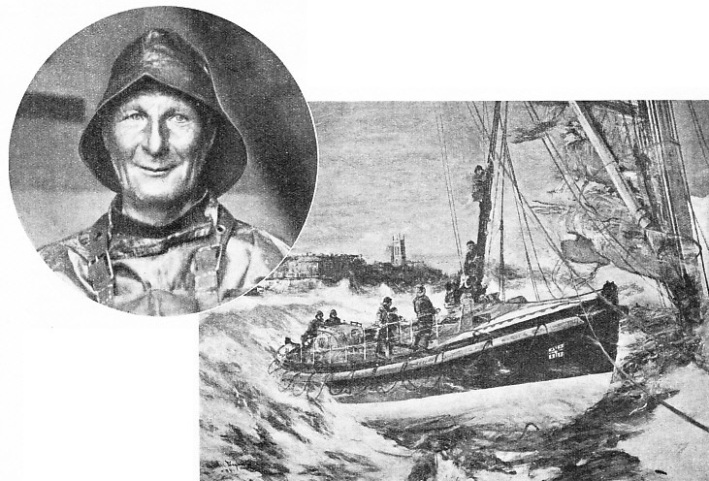
AN HEROIC RESCUE. On December 13, 1933, the sailing barge Sepoy was driven on to the shore at Cromer (Norfolk). For six hours a “pulling” lifeboat attempted to reach the stranded vessel, which was lying about 203 yards from the beach. Finally, the H. F. Bailey, a motor lifeboat, commanded by Coxswain Blogg,effected the rescue of the two men in the rigging of the barge. Shown here is a photograph of Coxswain Blogg, a famous lifeboatman, who received decorations for his bravery; to the right is an impression of the rescue.
Many ingenious devices are adopted in the modern lifeboat engine. Air is taken in through pipes high above the water-
The hull is stoutly built of two skins of mahogany or teak over a framework of rock elm and oak. Special care is taken to see that none but well-
Another interesting boat is the Sir William Hillary, stationed at Dover. This boat has been designed with a view to assisting aeroplanes that may have been forced down into the Channel, and she is, therefore, considerably faster than the ordinary types.
This fine modern vessel is 64 feet long by 14 feet beam, and is equipped with two 375 hp engines, giving her a speed of eighteen knots and making her the most powerful lifeboat in the world.
The up-
She carries a line-
Some of the modern lifeboats carry wireless apparatus. The most recent pattern used is radio-
The housing of the lifeboat presents a serious problem. The vessel must be kept where it is easily accessible and capable of being put into the water at any state of the tide and in the worst weather.
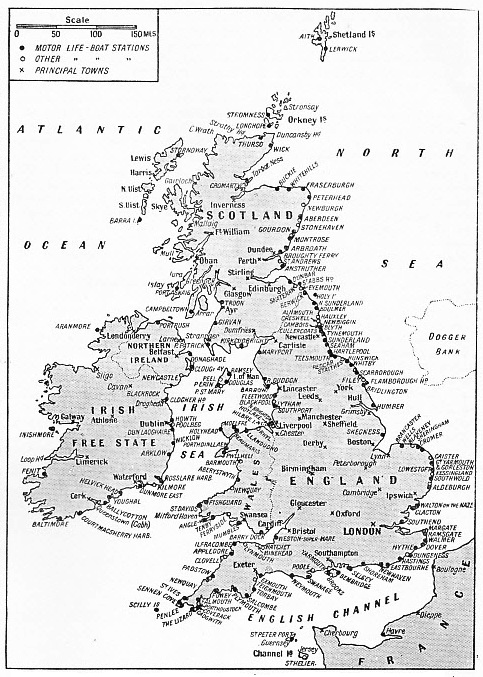
OVER 64,000 LIVES HAVE BEEN SAVED by the boats of the Royal National Lifeboat Institution since the institution’s inception in 1324. Round the British Isles the Institution has 169 stations, and at the present time there are 123 motor and forty-
In some places, as at Dover, Ramsgate, Yarmouth (Norfolk), and Padstow, to quote a few examples, the lifeboat can be kept in a sheltered harbour or river-
Another method is to keep the boat in a house at the head of a slipway, sometimes incorporated in a pier, as at Margate, the Mumbles (Swansea), Cromer (Norfolk) and the Lizard (Cornwall). Yet another method of launching is by a horse-
Two places that serve as illustrations of the difficulties of launching and housing are the Lizard and Newquay, both in Cornwall. At the Lizard the beach, such as it is, is hemmed in by cliffs and rocks, and it was a matter of considerable difficulty to find a site for the lifeboat. She is launched by means of a slipway, but the tides run so strongly that she cannot be hauled up it again on her return. She has to be run ashore, dragged up skids laid on the beach, put on a turntable, turned round and brought in through the back of her house.
At Newquay a team of horses had to haul the boat up a gradient of 1 in 2¾ to get her back to her house; but this station has now been closed, the district being adequately served by two motor lifeboats at neighbouring stations on either side.
At Porthleven, in Cornwall, the lifeboat house was built on rocks on the seashore. During a severe gale the seas broke through the doors of the house and forced the lifeboat up through the roof. That station has now been closed.
Most maritime nations possess lifeboat services. Four are maintained by Governments, and others are voluntary. Three countries that formerly had a State service, Germany, Spain and Norway, have reverted to the voluntary system, and Sweden has a service composed of State and voluntary sections. Russia, which had a privately run service under the Tsars, went over to the State system under the Soviet rule, but she has since gone back to a voluntary service.
The principal foreign fleets are those of the United States of America with 616 boats, Japan with 270, France with 109, Germany with 103, Denmark with sixty, Holland and Spain each with forty-
Romania is the latest recruit, a society having been formed whose initial letters spell the word “Salvamar”. Two British-
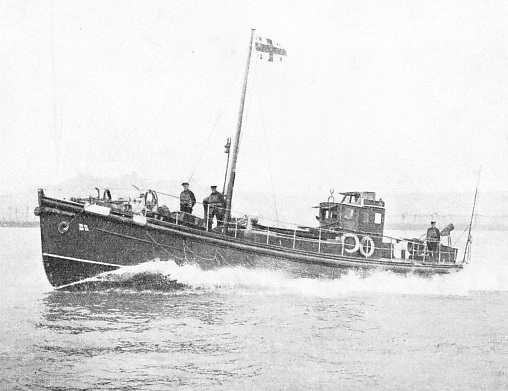 THE WORLD’S MOST POWERFUL LIFEBOAT. A fast motor lifeboat named after the founder of the Royal National Lifeboat Institution, Sir William Hillary. This boat, stationed at Dover, was built in 1930 and is 64 feet long by 14 feet beam. She was designed to go to the aid of aeroplanes forced down in the Channel. She is equipped with two 375 hp engines giving her a speed of 18 knots.
THE WORLD’S MOST POWERFUL LIFEBOAT. A fast motor lifeboat named after the founder of the Royal National Lifeboat Institution, Sir William Hillary. This boat, stationed at Dover, was built in 1930 and is 64 feet long by 14 feet beam. She was designed to go to the aid of aeroplanes forced down in the Channel. She is equipped with two 375 hp engines giving her a speed of 18 knots.
Among recent rescues off the English coast was one on December 13, 1933. In a gale, the sailing barge Sepoy was driven on to the shore at Cromer, Norfolk. The motor lifeboat stationed there had been called out to another. wreck, and the “pulling” boat was launched. It was got away from the beach with great difficulty, as the seas were so heavy and were setting on the beach. For six hours the lifeboat fought to reach the Sepoy, which was waterlogged about 200 yards off the beach, her crew of two having taken to the rigging.
The motor lifeboat H. F. Bailey, unable to return to Cromer, was making for Yarmouth when she was met by the lifeboat from Gorleston bearing the news of the wreck of the Sepoy. Coxswain Blogg, of the Cromer boat, immediately turned back again and tried to get his boat alongside the wreck, but the seas swept her away from the Sepoy at each attempt. Once a grapnel was got across, but a big sea smashed the lifeboat against the wreck, damaging the lifeboat and parting the grapnel line.
The position was almost desperate, and the two unfortunate men in the rigging of the barge were becoming exhausted. Coxswain Blogg, therefore, drove his boat right on top of the Sepoy and hung on just long enough for his crew to snatch one of the men from the rigging. Before the second man could be secured a sea had swept the lifeboat away, and once more she was forced on top of the wreck to reach him.
As soon as the rescue was effected, the damaged lifeboat was driven on to the beach at Cromer and the rescued men were landed. One of them was so exhausted that he had to be removed on a stretcher.
For his exploit Coxswain Blogg received a bar to the silver medal he already held. This hero has twice been awarded the Institution’s gold and silver medals, and has been decorated with the medal of the British Empire Order by His Late Majesty King George V.
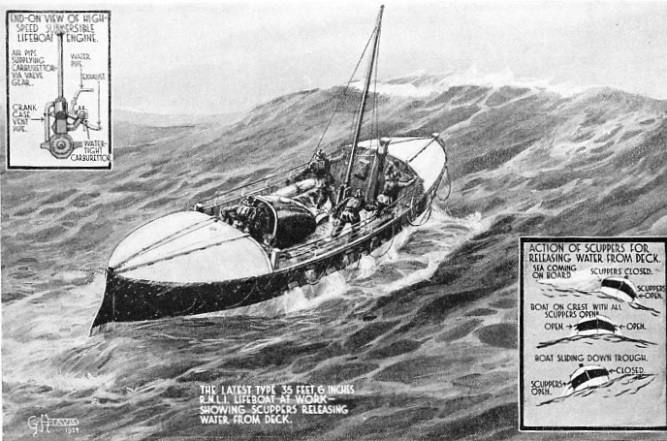
THE MODERN LIFEBOAT (see illustrations above and below) is notable for her ability to stand up to heavy seas. She frees herself of water, and has ample reserve of buoyancy when flooded. The hull is built of two skins of mahogany or teak over a framework of rock elm and oak. Up-
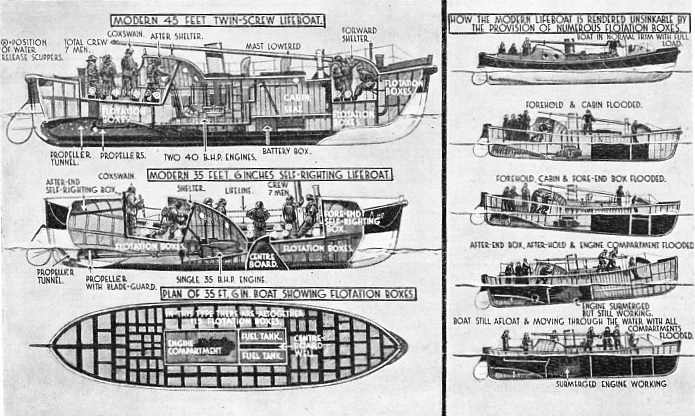
One January night the Peterhead lifeboat was called out to a trawler, the Struan, with a crew of nine, ashore on the rocks three miles away. It was dark and cold, a big sea setting on to the coast under a thick haze.
Soon after having left the harbour the lifeboat’s electrical gear went wrong and put the searchlight, compass and navigational lights out, leaving only a small hand torch for illumination. The coxswain located the wreck by the lights of the Rocket Brigade ashore, and tried unsuccessfully to reach the trawler with life lines.
The shipwrecked crew were clinging to the bridge of their craft, seas breaking over them. There was not a moment to lose. With only about a foot of water under her keel the lifeboat was driven alongside the wreck amongst the rocks. The coxswain was swept overboard by a heavy sea, but managed to hang on to the guard ropes and got aboard again. The motor mechanic, too, was injured. Six of the trawler’s crew jumped for their lives into the lifeboat. The seventh man misjudged his jump and fell into the sea, but was secured and hauled in. Still two men were left. Another big wave came rolling in, and the lifeboat’s engines were put ahead to meet it, but she was dashed up against the wreck and was nearly broken to pieces herself. Ten times the coxswain tried to reach the two men, and each attempt failed. At last, in desperation, lines were thrown across. The men tied the ends round themselves, jumped into the sea, and were dragged into the battered lifeboat.
The cargo steamer Porthcawl, loaded with esparto grass, caught fire and drifted, blazing, on to the beach near Yarmouth. Her crew of twenty-
The Italian steamer Monte Nevoso ran aground in thick weather on the Haisboro’ Sands, off the Norfolk coast. Although in great danger, the crew at first refused to leave her, hoping she would get off. The Cromer lifeboat stood by for twenty-
During the great gale in September, 1935, the Margate lifeboat, Lord Southborough, was called out at night to a small motor-
A whole N.W. gale was blowing, with a heavy sea and rain. The motor lifeboat Lord Southhorough, Civil Service No. 1, was launched at 2.40 p.m., And found the motor boat Sceptre, of Birchington, with five men on board. The Sceptre was full of water and foundered immediately after the men had been rescued.
While the lifeboat was on her way back to Margate the local motor boat Betty II, with two men on board, was seen to be in distress. Her engine had failed and she was drifting towards the rocks. A pilot boat had put off to help, but had been unable to get near her. The lifeboat managed to get to her and rescued the two men. The motor boat itself drifted on to the rocks. The lifeboat got back to harbour at about 4 p.m., and landed the rescued men.
Almost immediately she put out again to the help of a small boat reported to be in danger, but was recalled shortly afterwards as the boat had reached safety.
Conspicuous Bravery
During the gale of October 10, 1935, the sailing barge British Oak, bound from Goole for Hayling Island with a cargo of coal, got into trouble in the Downs, and four Deal boatmen went out to assist the crew of two. An attempt was made to sail into Ramsgate Harbour for shelter, but the gale drove them into the wall of the harbour and smashed the bowsprit. All the efforts of the crew could not save the barge from being driven ashore on Ramsgate sands. Coastguards, using the rocket apparatus, got lines aboard the wreck, but the seas were too heavy for them to be used. The Ramsgate lifeboat now appeared on the scene and, after making several attempts, succeeded in getting alongside and taking off all six men.
Christmas Day, 1935, was saddened by a tragedy at Aberdeen, when the lifeboat stationed there, the Emma Constance, made a conspicuously gallant effort to save the lives of the men in the trawler George Stroud. This vessel was attempting to enter the port at 8 p.m. in bad weather, when a huge sea dashed her against the north wall of the harbour.
The lifeboat was immediately called out and made four attempts to get alongside the trawler, which was bumping helplessly about in the narrow entrance. The lifeboat herself was thrown against the wall by the seas, and a rope got entangled round her propeller, putting the engine out of action.
While efforts were being made by a life-
Another man was saved by the shore crew. Three other men, however, were washed away by the seas and lost.
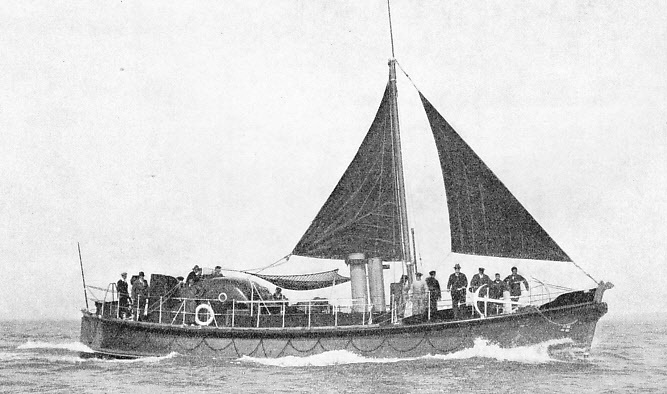
STATIONED AT PADSTOW, North Cornwall, the Princess Mary, built in 1929, is one of the finest lifeboats afloat. She is 61 feet long by 15 feet beam. She is driven by twin screws actuated by two six-
You can read more on “Heroes of the Trevessa”, “Heroism and Disaster at Sea” and
“Medals for Acts of Bravery” on this website.